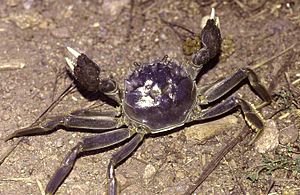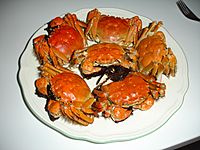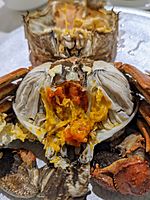Chinese mitten crab facts for kids
Quick facts for kids Chinese mitten crab |
|
|---|---|
 |
|
| Scientific classification |
| "Chinese mitten crab" | |||||||||||
|---|---|---|---|---|---|---|---|---|---|---|---|
| Traditional Chinese | 大閘蟹 | ||||||||||
| Simplified Chinese | 大闸蟹 | ||||||||||
|
|||||||||||
| Alternative Chinese name | |||||||||||
| Chinese | 上海毛蟹 | ||||||||||
|
|||||||||||
The Chinese mitten crab, also known as the Shanghai hairy crab, is a medium-sized crab. It is named for its furry claws, which look like mittens. These crabs are known for digging burrows.
It is against the law to import or sell these crabs in the entire European Union.
Contents
What Does a Chinese Mitten Crab Look Like?
The most special thing about this crab is the thick, dark fur on its claws. This fur looks like mittens. The crab's body is about the size of a human hand. Its legs are usually twice as long as its shell, which is about 3 to 10 centimeters (1 to 4 inches) wide.
Chinese mitten crabs live most of their lives in fresh water. But they travel back to the sea to have their babies. These crabs usually live for about one to five years.
Where Do Chinese Mitten Crabs Live?
This crab naturally lives in rivers, estuaries (where rivers meet the sea), and coastal areas of East Asia. You can find them from Korea in the north down to Fujian, China, in the south.
However, these crabs have also been brought to Europe and North America. In these new places, they are considered an invasive species. This means they are not native and can cause problems for the local environment.
Mitten crabs like estuaries with large areas of slightly salty water for their young to grow. They also need big, shallow waters for the young crabs to develop. In their native home, the Yangtze River, Chinese mitten crabs have been found as far as 1,400 kilometers (756 nautical miles) upstream. They can live in subtropical and temperate climates.
What Do Chinese Mitten Crabs Eat?
Chinese mitten crabs eat many different things. They are omnivores, which means they eat both plants and animals. Their main foods include worms, mussels, snails, and other small crustaceans and fish. They also eat dead plants and animals.
Tiny pieces of plastic, called microplastics, are becoming a problem for these crabs. Eating microplastics can affect how they grow and how their bodies work.
How Do Chinese Mitten Crabs Reproduce?
Mitten crabs move from fresh water to salt water to breed. In late August, they start swimming downstream towards the sea. They leave their feeding areas to find places to mate.
The crabs begin to breed in slightly salty water in late fall. The male crabs arrive first and stay in these waters all winter. The female crabs arrive later. Within 24 hours of mating, the female lays her eggs. She then attaches the eggs to her belly. After laying eggs, the female immediately leaves and heads towards the mouth of the river.
The baby crabs, called larvae, hatch from the eggs during the summer. They float and drift in the slightly salty waters. Because the journey to breed is so long and hard, these crabs usually only breed once in their lives. They typically breed towards the end of their lifespan. Since they only breed once, they lay a lot of eggs. After breeding, the crabs have very little energy left and become weak.
Here are the different stages of a mitten crab's life:
- Eggs need pure salt water to grow.
- Larvae hatch from the eggs in slightly salty water.
- The larvae slowly move from slightly salty water to fresh water.
- The last stage of the larvae is called a megalopa, which is about 3 to 4 millimeters (1/8 inch) long.
- The megalopa then grow into small mitten crabs in fresh water.
Why Are Chinese Mitten Crabs a Problem?
This type of crab has been spreading quickly from Asia (China and Korea) to North America and Europe. This is a big concern because they can compete with local animals for food and space. Also, their burrowing habits can damage riverbanks and block drainage systems. These crabs can travel far inland.
In the United States, it is usually illegal to bring in, move, or own live Chinese mitten crabs.
Chinese mitten crabs have also invaded waters in Germany. There, they damage fishing nets, harm native fish, and cause problems for local dams. This has led to millions of Euros in damage.
The first time these crabs likely came to Europe was on commercial ships. Ships take in "ballast water" to help them balance. If a ship filled its tanks during the mitten crab's spawning season, tiny crab larvae could have been sucked into the tanks. These larvae are very small, about 1.7 to 5 millimeters (1/16 to 3/16 inch). When the ship reached Europe and emptied its tanks, the crab larvae were released. Over time, this happened many times, leading to a large mitten crab population in Europe. The crab has now spread to many places, including Continental Europe, Southern France, the United States (like San Francisco Bay), and the United Kingdom.
Chinese Mitten Crabs as Food
Crabs are a special food in Shanghai cuisine and other parts of eastern China.
Crabs from Yangcheng Lake are especially valued. People believe they have sweeter meat. Most of the Yangcheng crabs are sent to Shanghai and Hong Kong. They are also sold in other countries where they can bring in a lot of money.
-
Hairy crab is an important part of Shanghai cuisine
How Are People Trying to Control Them?
Controlling Chinese mitten crabs has been very difficult. This is because there are so many of them. They also reproduce quickly and can survive in many different conditions. Several methods have been tried, but they have not worked very well. These include trying to catch as many as possible, building barriers to stop their migration, trapping them, and using electric screens.
There has been talk about catching the breeding crabs at the mouths of rivers. However, it has been hard to put this plan into action. Other ideas, like catching them when they gather at dams, have worked a little bit. But the problem is that the crabs can climb over the walls of the dams and get into the rivers behind them.
See also
 In Spanish: Cangrejo chino para niños
In Spanish: Cangrejo chino para niños




